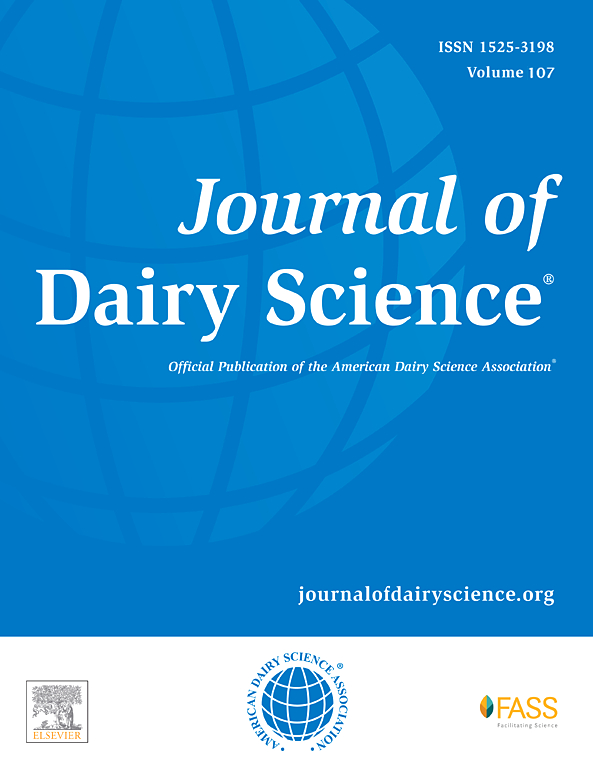Technical factors affecting estimation of nitrogen balance of dairy cattle in climate respiration chambers
IF 3.7
1区 农林科学
Q1 AGRICULTURE, DAIRY & ANIMAL SCIENCE
引用次数: 0
Abstract
Nitrogen retention is often overestimated when calculating N balance of dairy cattle. This study determined whether different N analysis methods (Kjeldahl [KJEL] or elemental analysis [EA]) and sample collection and storage protocols when using climate respiration chambers (CRC) affected the estimation of N intake, milk N secretion, manure N excretion, volatile N appearance, and N retention. Twenty-eight Holstein-Friesian cows were housed in CRC for a 4-d measurement period. Nitrogen intake was estimated using individual forages (corn silage and grass silage) and mixtures of forages sampled before or after storage at 4°C. Total N content of forages was the sum of NH3-N content in wet samples and N content in dry samples analyzed by KJEL and EA. Nitrogen content in dry concentrate samples was analyzed by KJEL and EA. Secretion of N in milk was based on N content in wet samples analyzed by KJEL and EA. Manure N excretion was based on the N content of wet manure samples with and without acid preservative analyzed by KJEL and EA. Volatile N consisted of N in condensed water from the CRC heat exchanger analyzed by KJEL, and aerial N. Aerial N was determined using an NH3 sensor or acid trap analyzed by KJEL. Volatile N was quantified during the 4-d measurement period (cow phase), CRC cleaning (cleaning phase), and between CRC cleaning and the next 4-d measurement period (postcleaning phase). Nitrogen content, with and without accounting for NH3-N, was higher in dry silage samples when analyzed using EA compared with KJEL. Nitrogen intake was higher when forages were analyzed by EA but was not affected by forage source (individual forages or forage mixtures pre- or poststorage) or interaction between forage source and N analysis method. Nitrogen analysis method did not affect the N content of milk or manure. Acid addition to manure samples did not affect N content on a wet basis but tended to increase the DM content of manure such that N content on a DM basis was lower in acid-preserved samples. There was no effect of aerial N analysis method (acid trap or NH3 analyzer) and no interaction between volatile N measurement phase and N analysis method on volatile N appearance. Nitrogen retention was lower when samples were analyzed using KJEL compared with EA (19 and 36 g/d, respectively), attributed to the lower N content of forages when analyzed with KJEL. The measurement phase used for estimating volatile N production did not affect N retention. Overall, N analysis method of forages affects the estimation of N intake but may be less important for milk and manure in terms of the effect on N retention. When using CRC to quantify volatile N, an acid trap or NH3 analyzer for aerial N can be used with similar outcomes. Although N analysis by KJEL resulted in lower N retention relative to EA, this may be artificial if KJEL underestimates N content of forages. Overestimation of N retention was not mitigated through the sampling or analytical approaches evaluated in this study.
求助全文
约1分钟内获得全文
求助全文
来源期刊

Journal of Dairy Science
农林科学-奶制品与动物科学
CiteScore
7.90
自引率
17.10%
发文量
784
审稿时长
4.2 months
期刊介绍:
The official journal of the American Dairy Science Association®, Journal of Dairy Science® (JDS) is the leading peer-reviewed general dairy research journal in the world. JDS readers represent education, industry, and government agencies in more than 70 countries with interests in biochemistry, breeding, economics, engineering, environment, food science, genetics, microbiology, nutrition, pathology, physiology, processing, public health, quality assurance, and sanitation.
 求助内容:
求助内容: 应助结果提醒方式:
应助结果提醒方式:


